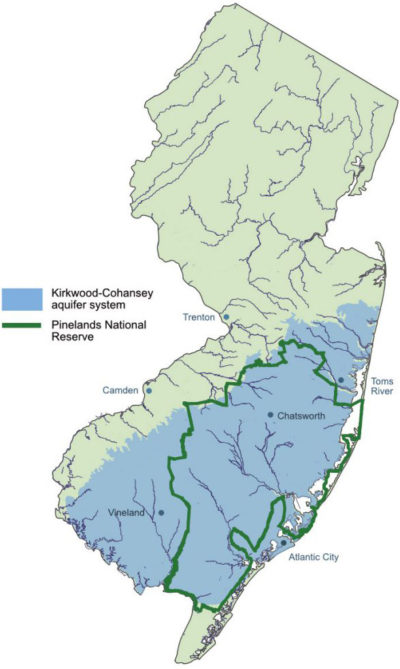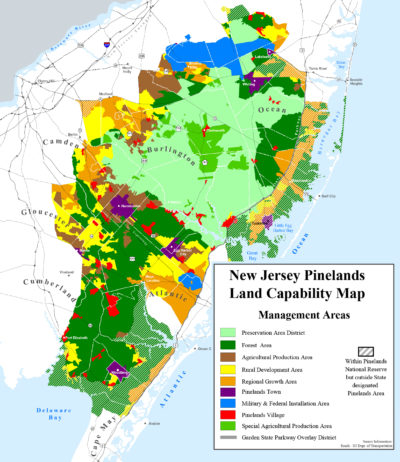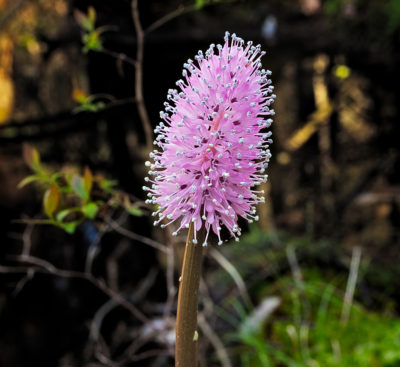新泽西州的Pinelands的持久性在如此高的工业发展和大都市蔓延的州中,这并不是一件小事。然而,在纽约市以南只有90分钟车程,就在95号州际公路以东,两车道的乡村黑顶进入了百万英亩的保护区,在这里,茂密的松树和橡木森林中的慢速溪流蜿蜒,阴暗的雪松和稀有湿地栖息地。国际认可的Pinelands Biosphere Reserve坐落在新泽西州沿海平原的横扫中,是里士满,弗吉尼亚州和波士顿之间最大的开放空间区域约22%of New Jersey’s land area.
直到20世纪中叶,这些黑田仍然在新泽西州的特拉顿工业特拉华河滨水区与卡姆登和州的大西洋渡假村之间保持了广阔的定居地区。基于该地区的沼泽铁和玻璃沙子的殖民工业已经一去不复返了。它的松树不再收获用于造船。除了在19世纪中叶开始种植蔓越莓和20世纪初的蓝莓之外,松树贫瘠的是保存完好的天然飞地。
With development pressures increasing in the 1960s and ‘70s and builders establishing subdivisions on the Pinelands’ margins, the state and federal government created the新泽西州新泽西国家保护区in 1978. A first-of-its-kind comprehensive ecosystem management plan, the reserve linked seven counties and 56 municipalities with federal and state governments in a coalition that would allow both rural and suburban development around the Pinelands perimeter while preserving the natural resources within — the extraordinary mosaic of habitats of this last great remaining stand of大西洋沿海松树贫瘠。
最近,对敏感的pinelands栖息地的天然气管道计划为拥挤的公开听证会,环境拥护者的诉讼以及针对新泽西州州长克里斯·克里斯蒂(Chris Christie)的政治操纵指控。但是,黑兰群岛目前面临一个更加生存的问题:随着对水的需求,发展,发展威胁到其纯洁和气候变化,Pinelands地下水储备的水文和生态完整性的威胁alters precipitation patterns.
Pinelands生态系统的生存能力取决于3,000平方英里,17亿加仑的水下的水Kirkwood-Cohansey含水层, one of the East Coast’s largest reserves of fresh water. Underlying nearly a third of New Jersey, the Kirkwood-Cohansey is an unconfined aquifer, meaning its waters are not capped by rock, but held within a surface layer of highly permeable sands and gravel. These sands soak up rainfall, leave little runoff, and are the source of the Pinelands slow, meandering streams and rivers, as well as its fragile wetlands.
稀有的沼泽粉红色植物以及罐头植物和糖果(两者都是食肉动物)在含水层的高酸性水中壮成长。在某些地方,含水层是如此浅,以至于它直接向沥青松树和雪松的根提供水,它们的茂密森林掩盖了秘密物种,例如木响尾蛇和稀有的松树淹没了树蛙。Kirkwood-Cohansey还为周围的高地农业以及Pinelands的商业蔓越莓沼泽和蓝莓农场以及100万南泽西州居民提供水。
关于失控发展对无限制含水层的影响的一堂课仅在纽约长岛东北150英里处。就像沿着新泽西州的沿海平原一样,长岛无限制的含水层(被称为上冰川)提供地下水和地表水。The aquifer once supplied nearly all of Long Island’s drinking water, but by the mid-1950s the Upper Glacial was already contaminated by nitrates, detergents, and synthetic organic compounds, the result of unrelenting suburban and industrial growth and agriculture Now, virtually all of Long Island’s residents who do not live in New York City, some 3 million people, take their water from the subterranean Magothy Aquifer.
The same period saw Long Island’s Pine Barrens diminish. Like New Jersey’s Pinelands, they are part of the coastalPinelands Ecoregion曾经从特拉华州北部延伸到马萨诸塞州科德角。Unlike New Jersey’s Pinelands, however, Long Island’s remained unprotected until 1993 when New York State passed the Similar to New Jersey’s Pinelands Reserve, it set aside some 100,000 acres to protect the 55,000 acres of core Pine Barrens remaining — reduced from an original quarter-million acres.
针对Pinelands的挑战是将含水层脱离外周开发和农业的影响的困难。
在长岛和新泽西州的Pinelands面临的挑战是,难以将含水层(甚至在受保护的土地下)与周边发展和农业的影响隔离开来。一种2014 report在新泽西州的Pinelands Reserve上发现,尽管成功地保护了60万英亩的Pinelands,但Kirkwood-Cohansey仍受到过去和现在开发,农业和化粪池系统的径流的影响。
一种s areas on the perimeter of the Pinelands reserve set aside for development increase in population, so will concerns over non-point sources of contamination. But perhaps most damaging are the increasing residential demands for water from a system that, as Rich Bizub, director of water programs for thePinelands保护联盟请说,“被淘汰了。”
新泽西州环境保护部(DEP)坚持认为,该州“有足够的水来满足其在可预见的未来的需求。”但是,正如Pinelands委员会土地使用和技术总监Bizub和Larry Liggett所见,当涉及到Kirkwood-Cohansey Aquifer时,这种乐观的预测仅在非常粗糙的规模上才是正确的。Bizub说,细节表明,DEP分配了比应有的水。在伯灵顿和海洋县的Pinelands边界上的住宅开发以及内部的农业撤离,将含水层推向了其极限。
Bizub说:“如果每个人都消耗他们的全部分配,情况就会黯淡。”他说,此外,国家不会以足够精细的规模来评估其生态影响。
这种关注尤其与依赖地下水的生态系统(称为GDE)相关,例如Pinelands,其中水抽水可以迅速改变水文学,并使植物和树根高而干燥。这些有价值的生态系统,写信梅利莎·罗德(Melissa Rohde)是加利福尼亚自然保护协会的地下水科学家,支持生物多样性,在河流,水净化,传粉媒介栖息地,防洪和供水中提供基本流量。188金博网注册就送188然而,她写道:“在全球范围内,随着人类剥削通常超过自然补给率,尤其是在亚洲和北美,GDE受到威胁。”
尽管很少有地方在水管理计划中立法考虑GDE,但加利福尼亚的《可持续地下水管理法》要求当地的5年地下水可持续性计划必须识别并考虑对GDE的影响。罗德说,澳大利亚是保护GDE的最先进的政策,这是由于经济发展的需求不断增长和气候变化增长的水压力而驱动。地下水提供了澳大利亚约30%的水需求,在该国易于干旱的西南地区,地下水可提供多达60%的水需求。
Rohde说,挑战是知道发生效果的阈值,然后量化这些影响,这需要涉及水文学家,地质学家和生态学家的昂贵研究。
一种s it happens, just such an expensivestudy- 550万美元 - 2003年在新泽西州发生,当时州,联邦和学术研究人员开始调查对柯克伍德 - 瓦恩西水上含水层的pinelands水结果生态系统的影响。
罗伯特·S·尼科尔森(Robert S. Nicholson)在研究水文作用的研究中,随后在美国地质调查局(US Geological Revery)模拟了模拟的水撤离水中的5%至30%的含水层在三个Pinelands排水盆地中的总体充值。结果是,即使最小的撤离也可能导致水位降低六英寸,占湿地总面积的10%,同时将基础流的流量减少多达9%。撤回30%的含水层充电可能会导致湿地几乎完全损失。
皮兰德委员会的own ecological study模拟地下水提取,以预测这些减少的流动对溪流昆虫和鱼类以及较浅的湿地栖息地的影响。
Pinelands委员会的首席研究科学家Kim Laidig说:“当我们在池塘植物群落上进行模拟时,我们发现一些物种对水深度的减少最小。”六英寸的缩水剩下的濒临灭绝的沼泽粉红色植物的30%以上,暴露于“极端水文条件”。两倍的缩水几乎可以消灭该物种。
只有建立可接受的变更阈值,您才能通过设置水的“速度限制”来提供安全余地。
一些物种,例如落叶灌木,皮叶和Highbush蓝莓,可能会证明更具弹性。但是,随着地下水位的不断下降,湿地森林开始变化,雪松和硬木沼泽让位于陆地松树绿色的森林和沥青松树。
同样的六英寸缩水也影响了Pinelands两栖动物的生命周期,例如南部的豹子青蛙,北春季偷窥者和松树贫瘠的树木青蛙,他们的春季幼虫需要间歇性的湿地才能在初夏之前有足够的水。
尼科尔森指出,取水的确切影响将取决于流域的地形,水文学和承载能力。仅皮纳兰斯就有223个子水。有些人会更脆弱。尼科尔森说,只有在建立可接受的变更门槛后,您才能通过设置他称之为水的“速度限制”来提供安全余地。
Bizub说,Kirkwood-Cohansey的研究表明,“当您看到溪流流失时,您已经真正浪费了很多湿地。在Pinelands的许多地方,这一缩水量已经超过5%至10%。”
一种nd yet, years after the completion of these extensive Kirkwood-Cohansey studies, neither the state nor the Pinelands Commission has acted upon any of the findings. Indeed, what Governor Christie has made clear through his appointees on the Pinelands Commission is that approval of two new natural gas pipelines is a priority.
稀有的沼泽粉红色植物在Kirkwood-Cohansey Aquifer的高度酸性水中蓬勃发展。礼貌阿尔伯特·D·霍纳(Albert D. Horner)
In February, the commission — over protests that included a letter from four previous New Jersey governors, Republican and Democrat — approved a pipeline that would traverse 22 miles of Pinelands. The Sierra Club and the Pinelands Preservation Alliance immediately brought suit against the commission. Pipeline supporters and protesters engaged again at a July 26 hearing on a second, 30-mile pipeline that would run adjacent to sensitive Pinelands preservation land. The legal issues focus on whether the Commission’s decisions run counter to the mandates of the reserve’s comprehensive management plan. The environmental issues focus on the risks that pipeline construction, maintenance, or leaks might pose to local residents, the Pinelands ecosystem, and the Kirkwood-Cohansey Aquifer.
Meanwhile, says Bizub, the state DEP continues to over-allocate water supplies. For instance, in the southernmost extent of the Kirkwood-Cohansey aquifer that provides water to the Maurice River, virtually every watershed is stressed. Next to the Delaware River itself, the Maurice is Delaware Bay’s largest freshwater tributary. The shortage of stream flow has allowed saltwater to infiltrate into the freshwater aquifer.
Right now, says Liggett, the Pineland’s Commission’s rules for dealing with water withdrawals are vague. “They require that there be ‘no adverse impact,’ but what does that mean? How is it measured? A foot of drawdown in a wetland is easy to measure. But six inches? Three inches?”
The Kirkwood-Cohansey studies made clear the links between the aquifer and the ecosystem, says Bizub. Now the question is whether the political will exists to deal with its implications — in particular, the possibility of limits on growth.
Liggett说:“我们一直向州长办公室发送有关新规则的建议和建议。”“但是我们没有答案。”




